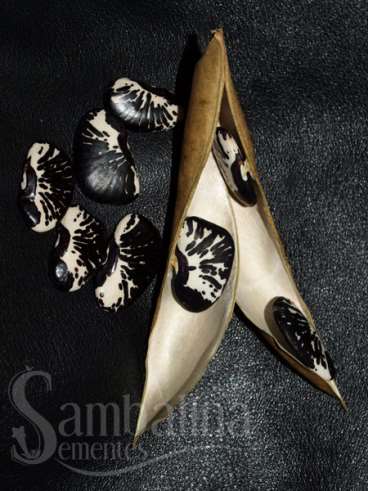
 1
1




Brenda
Bloom where you are planted.
http://restfultrailsfoodforestgarden.blogspot.com/
 5
5




 2
2








Charley Hoke wrote:Or you could tie a string across the bottom and tie the dangle strings to that.
I get a lot of wind here too, I actually cut the strings a foot or so longer than I need and lay it directly on the plant. it's amazing how quickly the plants grab hold and once they do wind is not an issue. I keep check on them and help them out till they get going, once they do I just let them go.
Something has been killing my cucumbers so I adopted this method with them and it seems to have helped. The cukes need more training and help but it seems to be working out well.




Charley Hoke wrote:I like growing green beans almost as much as I like eating them. We grow both pole beans and bush beans. I prefer the pole beans because if properly trellised take up less room, but have always detested the complicated trellis systems that I have used in the past. Last year I discovered a simpler way.
First, I keep my rows around 10 feet long and 2 feet apart; I put a wood steak at the ends of the rows sticking about 6 feet out of the ground. Then I tie a stick at the top of each steak to connect them. Then I tie an old piece of bailing twine to the cross stick and let it dangle down to the bean plant. I repeat this for each plant.
The beans will climb the twine and because it dangles, it makes it easier to harvest reaching between the plants as they sway freely. This concept makes it easier in the fall too. When the plant dies and if I have used twine made from jute or other natural fiber, I simply cut the twine loose from the cross stick, pull the bean plant from the ground and toss the whole thing in the compost pile.





 9
9







 5
5






 1
1




 1
1




I make a Maple Syrup instructional movie! Check it out HERE
SKIP books, get 'em while they're hot!!! Skills to Inherit Property
See me in a movie building a massive wood staircase:Low Tech Lab Movie

 2
2




paul wheaton wrote:Would jute work as a baling twine?
List of Bryant RedHawk's Epic Soil Series Threads We love visitors, that's why we live in a secluded cabin deep in the woods. "Buzzard's Roost (Asnikiye Heca) Farm." Promoting permaculture to save our planet.
 3
3




Bryant RedHawk wrote:
paul wheaton wrote:Would jute work as a baling twine?
You should be able to find either jute or manila bailing twine Paul, that is the "old school" bailing material.
Our farm supply store says they can get me the natural fiber bailing twine in the big balls just like they used to carry it.
or try these on line sources; agrisupply and sisal bailer twine and nursery supplies
Redhawk
















List of Bryant RedHawk's Epic Soil Series Threads We love visitors, that's why we live in a secluded cabin deep in the woods. "Buzzard's Roost (Asnikiye Heca) Farm." Promoting permaculture to save our planet.
 12
12






"Also, just as you want men to do to you, do the same way to them" (Luke 6:31)
 1
1




Charley Hoke wrote:I don't see why jute would not work as bailing twine, it is a very strong fiber.
I'm not sure if the twine I have gotten in the past was jute or not, but it was a natural fiber, at least it looked like it.
For the last couple of years the twine I have been getting is an orange plastic type.
This is an interesting article I found on jute
http://www.wisegeek.com/what-is-jute.htm




No Excuses Suburban Garden
300 total sq. ft. intensively cultivated, hugulkultur beds, producing at over 500lbs or $1500-5k of food annually in Zone 5b.
6 chickens worth of droppings, bedding, and 3 peoples worth of food waste provide plenty of compost to keep the beds growing indefinitely.
$500 up front cost(minus reclaimed materials): includes loam and compost, lumber for building beds and chicken coop, tools, chickens, and fencing for garden and chicken run, rain barrels or buckets
$300 upkeep costs(minus reclaimed supplies): includes seeds, chicken feed, mulch and water.




David Wieland wrote:
Charley Hoke wrote:I don't see why jute would not work as bailing twine, it is a very strong fiber.
I'm not sure if the twine I have gotten in the past was jute or not, but it was a natural fiber, at least it looked like it.
For the last couple of years the twine I have been getting is an orange plastic type.
This is an interesting article I found on jute
http://www.wisegeek.com/what-is-jute.htm
When I was homesteading in Ontario in the 70s, plastic baling twine was coming in, but natural sisal was still available. The jute twine I have on hand is softer and weaker than sisal. It's also not nearly as heavy as baling twine, but it works for one-season trellising.
Blazing trails in disabled homesteading
 4
4









Bottom left is sweet potatoes... little grasshoppers are starting to chop 'em ... grrrr.[/quote wrote:
Now if only a way to train sweet potatoes over the fishNice aquaponics description. How many pumps are you using?
Bless your Family,
Mike
 2
2




 1
1




A human being should be able to change a diaper, plan an invasion, butcher a hog, conn a ship, design a building, write a sonnet, balance accounts, build a wall, set a bone, comfort the dying, take orders, give orders, cooperate, act alone, solve equations, analyze a new problem, pitch manure, program a computer, cook a tasty meal, fight efficiently, die gallantly. Specialization is for insects.
-Robert A. Heinlein
 2
2




 1
1




Well behaved women rarely make history




I make a Maple Syrup instructional movie! Check it out HERE
SKIP books, get 'em while they're hot!!! Skills to Inherit Property
See me in a movie building a massive wood staircase:Low Tech Lab Movie
 2
2




A human being should be able to change a diaper, plan an invasion, butcher a hog, conn a ship, design a building, write a sonnet, balance accounts, build a wall, set a bone, comfort the dying, take orders, give orders, cooperate, act alone, solve equations, analyze a new problem, pitch manure, program a computer, cook a tasty meal, fight efficiently, die gallantly. Specialization is for insects.
-Robert A. Heinlein




I make a Maple Syrup instructional movie! Check it out HERE
SKIP books, get 'em while they're hot!!! Skills to Inherit Property
See me in a movie building a massive wood staircase:Low Tech Lab Movie




Well behaved women rarely make history
 1
1








I make a Maple Syrup instructional movie! Check it out HERE
SKIP books, get 'em while they're hot!!! Skills to Inherit Property
See me in a movie building a massive wood staircase:Low Tech Lab Movie
 1
1




 3
3




 3
3




I make a Maple Syrup instructional movie! Check it out HERE
SKIP books, get 'em while they're hot!!! Skills to Inherit Property
See me in a movie building a massive wood staircase:Low Tech Lab Movie








I make a Maple Syrup instructional movie! Check it out HERE
SKIP books, get 'em while they're hot!!! Skills to Inherit Property
See me in a movie building a massive wood staircase:Low Tech Lab Movie




 maybe we will start seeing some designs of bean teepees..
maybe we will start seeing some designs of bean teepees..




Charley Hoke wrote:I like growing green beans almost as much as I like eating them. We grow both pole beans and bush beans. I prefer the pole beans because if properly trellised take up less room, but have always detested the complicated trellis systems that I have used in the past. Last year I discovered a simpler way.
First, I keep my rows around 10 feet long and 2 feet apart; I put a wood steak at the ends of the rows sticking about 6 feet out of the ground. Then I tie a stick at the top of each steak to connect them. Then I tie an old piece of bailing twine to the cross stick and let it dangle down to the bean plant. I repeat this for each plant.
Southern Ontario, Canada
www.smallbones.ca
 1
1








Thanks for your kindnesses,
Christine

|
And that's when I realized I wasn't wearing any pants. Maybe this tiny ad has pants:
The new gardening playing cards kickstarter is now live!
https://www.kickstarter.com/projects/paulwheaton/garden-cards
|









